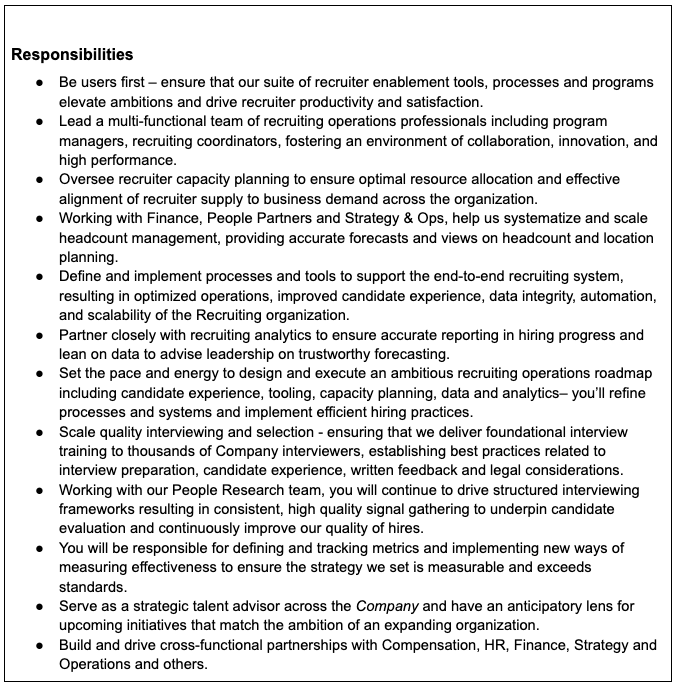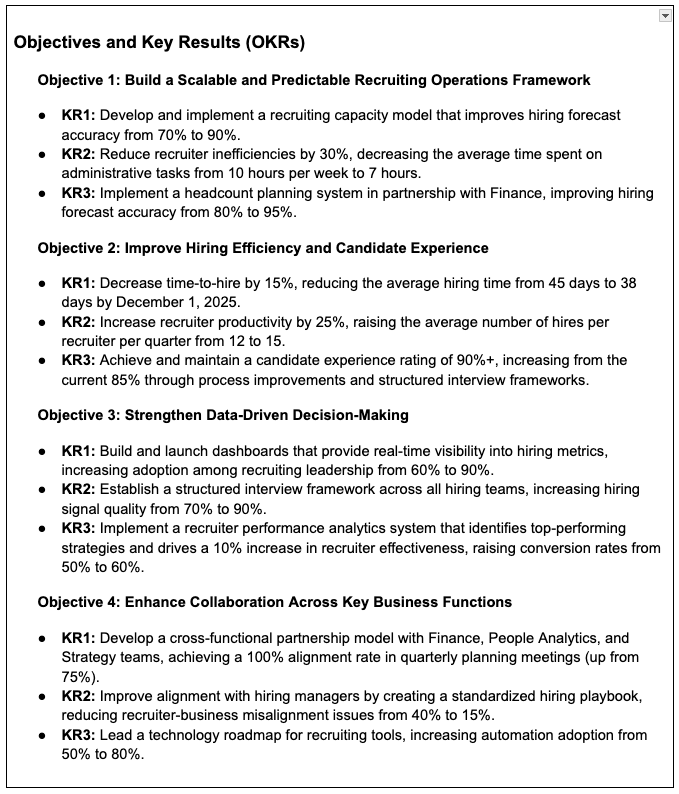Job Descriptions Built for Hiring, Performance, and Business Success
The best job description will attract the right people, repel the wrong people, drive alignment and structure in the hiring process, and bring performance objectives in right from the start.
When you hear, "we have a new role to hire for and need to create the job description,” what did you experience?
Did that make you cringe at the thought of creating another generic job description or did you get excited about the possibilities to leverage your writing, format, and creativity to use the most powerful form of attracting someone into the role?
Job descriptions can be viewed as a necessary frustrating task or you can leverage them to the absolute fullest and recognize that they can be the most important part of the entire hiring process.
What if we can create powerful hiring outcomes by crafting a better job description?
The best job description will attract the right people, repel the wrong people, drive alignment and structure in the hiring process, and bring performance objectives in right from the start.
This drives alignment on what we are hiring for and why. Roles are approved for hiring because the business case is built in.
In this article, I'll attempt to explain why job descriptions are the most important sharpen the ax strategy.
Current State Job Descriptions
Too often, job descriptions are a list of requirements, expectations, and a generic list of what the candidate will be doing. Rarely do companies talk about who the candidate will become or what they need to deliver in outcome-driven terms.
We Leave Out the Most Important Details
Provide Transparency
Share as much as you can to attract the right person. There may be fear about putting your weaknesses and threats out there for the world. This might be your most powerful opportunity to attract the right people.
Is this a brand new role or are you replacing the fifth person to leave the company? If it is a brand new growth position, tell them! You might even want to talk about the previous five people in the role and what they’ve gone onto. Consulting companies love showcasing their alumni.
"Our last five GTM Recruiters are now leading the GTM hiring function in these industries."
"We have no expectation you will stay with us forever. We’d love it if you did, and we also recognize your career path is your own. We’ll give you X, and in return we’d like Y." [See The Alliance for more context.]
Present the Path
Give clarity on exactly what the interview steps are and how much time they’ll spend with you. Let them know who they’ll meet in the interview process. This highlights to candidates that you likely have a structured hiring process.
Perhaps even let them know when you plan to make a decision on the role and what your target start date for the role is.
Who wrote this?
There are many tools and platforms that help us with job description creation. Do we run the risk of losing the impact of who wrote the job description and the insight it provides candidates? Did the Recruiter, HR Business Person, Hiring Manager, or an AI tool write this job description?
As a candidate I want to know the personality of the hiring manager. I want to know how they write and think, including the language and tone they use. If someone is rude, and it comes through in their writing, I’d rather you not shield that from me.
Job Descriptions like a Sourcing Strategy
A job description is very comparable to a sourcing strategy. It will bring the right people in and also help candidates self-select out.
When sourcing and I find the perfect candidate for a role, I attempt to enter their frame of mind and write an outreach message specifically for them. Job descriptions are no different. We need to understand the type of candidate we need to attract. The personality, their ambitions, their skills, and how we might interest them in having a first conversation.
Jim Miller has some great practical tips in this Quality of Hire article.
"Great job descriptions attract and retain the right people....ensure the job title is clear, accurate, and matches industry standards....[the target] candidates should [read the job description and] see themselves confidently enjoying the role."
A Targeted, Clear Title is Essential
When I was sourcing, if I didn't get the recipient to open the email, it didn't matter if I offered them one free Bitcoin to chat with me. They were never going to open and see my message. The same can be said for job titles. If you can’t capture their attention in one to two seconds they are not reading your job description. If your title doesn’t hook someone, they are not reading anything about your company, team, or role needs.
Head of Recruiting Operations is a much better title, though maybe not as fun as what ChatGPT came up with:
- Grandmaster of Hiring Chaos & Control
- Architect of Scalable Hiring Realities
- Head of Human Funnel Engineering
- Chief Efficiency Overlord of Hiring
- Gatekeeper of Hiring Velocity & Sanity
- Duke/Duchess of Data-Driven Hiring Mayhem
Now that you have your target person moving to the next level of engagement. You need to create a vision for the role and why your target candidate should see themselves thriving in this role.
Unless you have a known company brand, most people want to understand what the company delivers and what the team is responsible for. There are likely industries each person would not want to work in.
Who do you want to attract?
Your job description should be aligned to the person you want to attract. Do you need someone to solve a lot of complex challenges? Do you need someone to maintain an existing system? How you communicate in the description should be aligned to the target candidate. Write it for an audience of one.
Pull the right person in. Describe in detail the current state, what they need to accomplish, who they’ll become by joining you, and let them know you need them!
Job Descriptions as a Performance Evaluation
Treat job descriptions like an outline for future performance evaluations. Make your job description outcome based. Don't just list tasks and duties. Focus on the target outcomes and results.
By specifying exactly what you need the candidate to achieve, you’ll have better expectation alignment and interview conversations.
Objectives and Key Results (OKRs)
Objectives focus on what you want to achieve and should be ambitious and inspiring. Key results are how you measure progress to the objective and should be specific and measurable.
If OKRs bring clarity for an organization and what they need to focus on, could we bring this to our job descriptions?
I find most job descriptions are cryptic. They don't tell you exactly what the current state is. Then most of your interview questions as a candidate are focused on fact finding information that could easily be listed in the job description.
OKRs create clarity and work very well when the team responsible for delivering on the OKRs has influence in the creation process.
Here is a Head of Recruiting Operations job description I found online. This is an example and not in any way a knock on the company.

This is a very all-encompassing job description and gives a lot of context on what every Head of Recruiting Ops person could expect in the role. It even allows you to infer where their current main pain points might be. Capacity planning and Forecasting appear in the description before structured interviewing and metric tracking and this signals those might be the most pressing challenges to address.
Now, let's copy/paste this job description into ChatGPT and ask for an OKR output of the job description.

Now everyone is clear on exactly where we are today and what the target is. The candidate interviewing for the role has extreme clarity on what they need to achieve by when. Their performance review now has clear metrics. The team working on influencing this metric has a clear goal and target. Everyone should be aligned.
Would there be value in business leaders, finance, hiring managers, HR business partners, and recruiters all being aligned on the performance objectives from the start?

Structured Interviewing
We now can create an extremely well defined structured interview process and question set aligned with what we need to achieve.
Instead of a question in an interview like, "how have you improved hiring efficiency in your previous roles?"(an Objective) interviewers can focus on specific initiatives on how to reduce time to hire. This clarity might even enable the candidate to ask why time to hire is such a focus area for the hiring team.
Maybe the company analyzes their data and knows that candidate withdrawals and offer acceptance rates go down significantly for any candidate that is in process for longer than 40 days.
A written exercise could be detailing the initiatives that would lead to the desired key result. It allows the candidate to understand the exact challenges and opportunities ahead for them.
OK, now that we have created our OKRs, we can turn our attention to specifying the skills and experience that may be useful for SEO and job board aggregator surfacing.
Lateral Hiring vs Potential
Are you intentionally focused on hiring for direct past experience vs competencies, skills, outcomes and results?
Learning agility is a key for hiring an adaptable team. Make sure you are not so focused on hiring people into lateral roles that you have no system or structure in place to shift your hiring approach as soon as a change in market conditions shifts from employer to a candidate driven market.
Metrics to Track
What metrics could we consider to test the results of moving towards performance-based job descriptions?
- Quality of Applicant: Are you attracting the candidates you need?
- Quality of Hire: Are your hires performing as expected?
- Offer Acceptance Rate
- Hiring Efficiency: Are you reducing the effort it takes to make a hire?
- Hiring Plan delivery (Target Start Dates achieved)
- Hiring Manager and Candidate NPS
- Sourcing response rates
- Talent Density
Quality of Application(QoA)
One metric to review is the Quality of Application(QoA). I calculate this by dividing the total number of candidates who moved into the next step of the interview process divided by the total number of applications. This gives me a good indication of the quality of our brand and on the role level, the quality of our job description.*

If we generate enough high quality applications to have an initial conversation, we set ourselves up for success to end our interview process with a high quality hire. Improving our QoA is important. (If you want to understand why, I talk about the impact of rejecting candidates here.)
Evaluate your current metrics with your existing job descriptions and compare to any new changes you make based on everything shared above. You can assess which has a better impact on your company.
Closing
When I shifted my previous company’s job descriptions to be forward looking and performance based, we received so much positive candidate feedback on the refreshing approach to job descriptions and clarity it achieved.
I hope by now you are inspired to think about the impact a well informed job description can have on your hiring. Clear descriptions can attract the right candidates, establish interview questions to ask based on present and future state, and even provide a useful framework for future performance reviews.
If we put in the up front effort to create the clear vision and outcomes needed for the role, we are likely to see:
- easier role approvals from the business
- better candidate quality
- reduced hiring effort and
- ultimately better business outcomes as we brought transparency, clarity, and thoughtful execution at the beginning.
So, the next time you write a job description, view it as an opportunity to positively impact the trajectory of your company.
Comment Time
Let me know in the comments, which companies stand out to you in the way they craft their job descriptions? Have you ever been so impressed with a company’s job descriptions that you just had to work there?
*this isn’t the complete picture. There are always going to be people who apply because they want to work at your company, or apply even without the required competencies and skills. One preferred metric to consider is the candidates who the recruiter had to review and were not automatically flagged for rejection based on application questions that asked about their objective experience.
